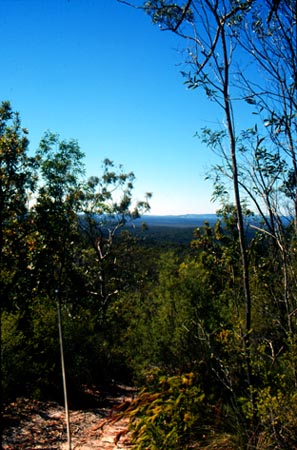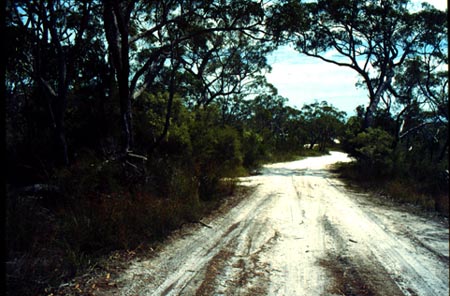 Great Sandy National Park is located on the coast northeast of Gympie, southeastern Queensland, Australia. The park is divided into two sections, the northern section being Fraser Island and Cooloola forming the southern section. Our collecting trip surveyed the Cooloola section. The vegetation of the park is a mix of rainforest, dry sclerophyll forest, and open heathland. The soil is sandy with a thin humus layer.
Great Sandy National Park is located on the coast northeast of Gympie, southeastern Queensland, Australia. The park is divided into two sections, the northern section being Fraser Island and Cooloola forming the southern section. Our collecting trip surveyed the Cooloola section. The vegetation of the park is a mix of rainforest, dry sclerophyll forest, and open heathland. The soil is sandy with a thin humus layer.
The collecting trip was made from September 29 to October 5, 1996. Participants on the trip were Dr. David Yeates, postgraduate students Shaun Winterton, Christine Lambkin, Brian Weiss, and undergraduate student Jodie Christensen. The township of Rainbow Beach, located in the park, was used as a base from which daily trips where made.
Except for the heavy rain on the first day, the rest of the week had clear skies with temperatures between 20-32 degrees Celsius–good for collecting Diptera. Malaise traps were set up along tracks and dry creek beds in a variety of habitats, including rainforest, open and closed sclerophyll forest, and heathland. Traps were emptied about the same time every day before 9am in the morning and between 4 pm and 5 pm in the afternoon. Sweep netting was done in these habitats during the day between these times.
Many different orthorrhaphan Diptera were collected during the week. Families collected include: Asilidae, Tabanidae, Bombyliidae, Acroceridae, Pelecorhynchidae, Apioceridae, Stratiomyiidae, Nemestrinidae, Rhagionidae, and Therevidae. Many other Diptera were collected including Tachinidae, Conopidae, Empididae, Tipulidae, Axeniidae and Platystomatidae.
Thirteen species from seven genera of Therevidae were collected on the trip. These are listed below according to the habitat where they were found.
Therevidae species collected (genus names followed by sp. 1,2,3..= unidentified and/or undescribed species):
Rainforest:
New Genus sp. 7
Anabarhynchus sp. 1
Anabarhynchus sp. 2
Anabarhynchus sp. 3
Ectinorhynchus ? sp. 1
Acupalpa sp. 1
Beach fore-dunes:
Ectinorhynchus sp. 2
Parapsilocephala aggera
Closed sclerophyll forest:
Anabarhynchus sp. 3
Anabarhynchus sp. 4
Acupalpa rostrata
Acupalpa sp. 1
Acupalpa sp. 2
Ectinorhynchus sp. 2
Open sclerophyll forest and heathland::
Agapophytus australiasae
New genus sp. 1
Neodialineura sp. 1
Acupalpa rostrata
Many species were collected on Leptospermum blossoms. Agapophytus australiasae and New genus sp. 1 were collected on the trunks of smooth barked Eucalyptus (scribbly gum). There was no apparent pattern to tree selection by these species, with flies locally abundant (up to 7 individuals per tree) on 2-3 trees in an area, then none for some distance away. In the rainforest,Anabarhynchus spp. and Ectinorhynchus? sp. 1 were often collected in small, sunlit clearings where female Anabarhynchus were often observed ovipositing in the sand. Ectinorhynchus? sp. 1 were observed moving their pale coloured fore-tarsi like antennae, presumably mimicking the behaviour of a species of pompilid wasp common in the area.
